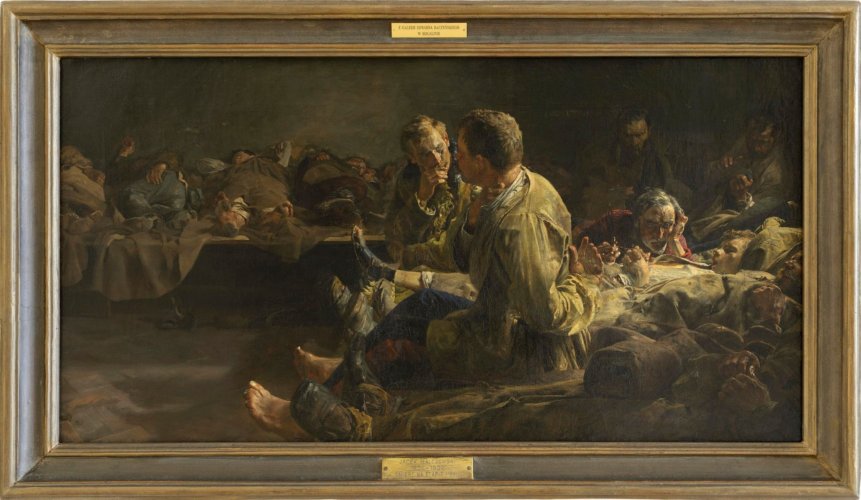Description:
Jacek Malczewski (1854-1929) inherited his love for art and romantic literature, particularly Juliusz Słowacki’s poetry, from his family home. He came from a noble but not wealthy family. His father Julian supported him in his career as a painter. The events of 1863, the January Uprising and the subsequent repression, left a lasting impression on the young artist. His first teacher was Adolf Dygasiński. He spent his teenage years from 1867 to 1871 at his uncle’s manor in Wielgim. In 1873 he started studying at the Cracow Academy of Fine Arts under the tutelage of Jan Matejko and was a student of Władysław Łuszczkiewicz. He also studied at the École des Beaux-Arts in Paris. He traveled to Italy, Vienna, Munich, Greece and Asia Minor. From 1896 to 1900 and from 1910 to 1914 he was a professor at the Academy of Fine Arts in Cracow. From 1912 to 1914 he was its rector. He started out with idealizing realism, then naturalism, and his works during this period were mainly about exiles in Siberia and Juliusz Słowacki’s “Anhellim”. At the same time, fantastic and allegorical elements began to appear in Malczewski’s works. After his father’s death in 1884, the motif of Thanatos, the god of death, returned to his works. After 1890, his art became entirely symbolic. Works such as “Introduction” (1890), “Melancholy” (1890-1894) and “The Vicious Circle” (1895-1897) manifested this turn towards symbolism. The artist addressed existential, historical and artistic topics, combining classical and biblical motifs with local folklore and the all-important Polish landscape. Form, color, monumentality and expression became his distinguishing features.
Description of the picture:
In the horizontally cut composition we can see a group of exiles during their night rest on their way to Siberia. Among the anonymous figures emerging from the darkness, the attention is drawn to the figure of a boy in tattered shoes, an unbuttoned shirt and prayerfully folded hands. The old man watching over him fastens a cross on them. Leaning on his hand, he looks with resignation at his still childish face. Two younger companions join in. The rest are sleeping or discussing, without paying attention to the drama unfolding behind them.
The muted, brown-green tone of the scene is brought to life by the reddish clothing of the old man and the light coming from the side. By bringing out of the darkness the figure of the boy, it confronts us with his death. At the same time, it fills it with a sacralizing mystery, signaled by the cross next to it and the red robe of the old man holding him. Since biblical times, red has been a symbol of suffering and resurrection, but also of “the boundless love of God, which is the ultimate source of both the work of creation and the redemption of the whole world”. It is striking how this scene, without any pathos, has an extraordinary realism. It is related to the circle of naturalistic painting of the European second half of the 19th century, whose subjects were representations of miserable dwellings and workshops, shelters for the elderly, or scenes of death, funerals and cemeteries with an almost reporter-like objectivity. However, this fascination with poverty and misfortune has been enriched, in a characteristic Malczewski way, with a spiritual element stemming from the artist’s reference to the messianic philosophy of Polish romanticism. Thanks to this, all the more or less hidden references to the compositional schemes of biblical paintings, the exposition of religious motifs, the evaluation of ethical stances outlined, and the overriding tone of the entire set of acceptance of suffering and sacrifice become clear.
We also know that the inspiration for this was not “Anhelli” by Słowacki, which determined the patriotic-martyrdom trend of Malczewski’s early Siberian paintings, but the work of August Cieszkowski “Our Father”. According to the artist’s intention, known thanks to Maria Konopnicka’s testimony, “Death on the Stage” was to be part of a larger metaphorical cycle “Our Father”, in this case referring to the invocation “but deliver us from evil”. In a messianic synthesis of the world’s history and the fate of man related to the absolute, the understanding of the past and the present was dominated by the conflict between good and evil in view of future final goals – the fulfillment of the “Kingdom of God” in history. Within this optic, the suffering of Poland and the nation became a transitional state, a sign of election to new callings, of a suffering of purification and sacrifice (comparable to Christ’s) for all mankind. It also guaranteed the future triumph of freedom and the certainty of resurrection.


